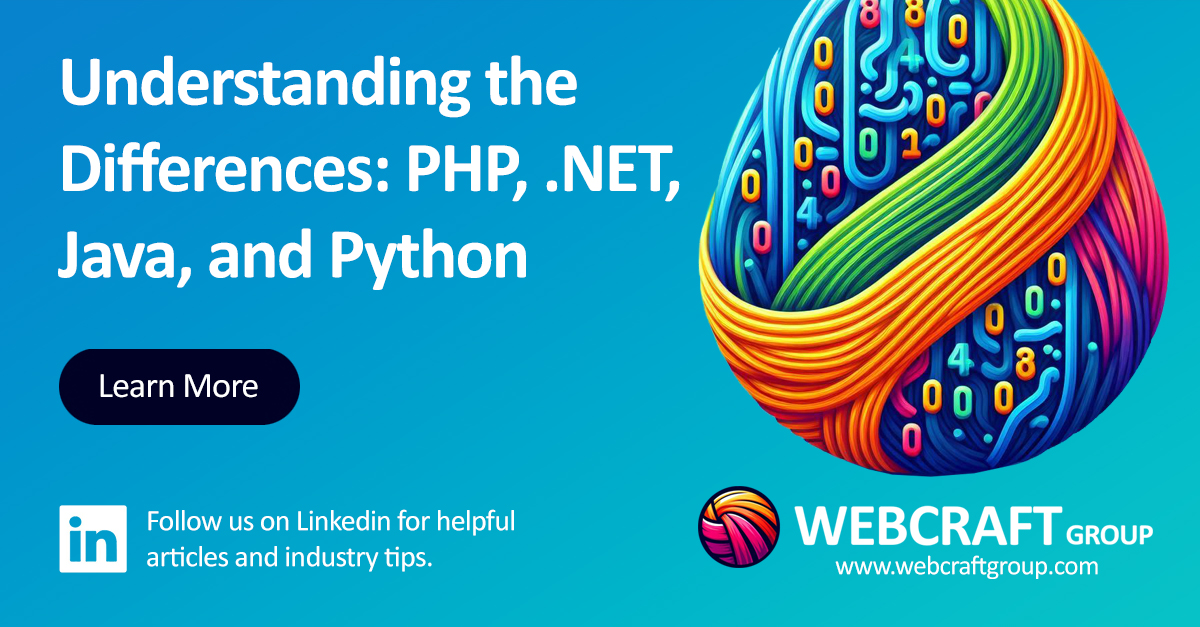When it comes to programming languages and frameworks, developers have a plethora of choices, each with its unique strengths and use cases. In this comparison, we delve into the distinctions between PHP, .NET, Java, and Python to help you make an informed decision for your next project.
PHP
Overview: PHP (Hypertext Preprocessor) is a server-side scripting language designed specifically for web development. It is widely used for creating dynamic web pages and applications.
Key Features:
- Simplicity: Easy to learn and use, especially for beginners.
- Embedded Code: Can be embedded directly within HTML.
- Cross-Platform: Runs on various platforms including Windows, Linux, and macOS.
- Open Source: Free to use, with a large community contributing to its development and support.
Use Cases:
- Content Management Systems (CMS) like WordPress, Joomla, and Drupal.
- E-commerce platforms like Magento and WooCommerce.
- Social networking websites and forums.
.NET
Overview: .NET is a framework developed by Microsoft that supports multiple programming languages, including C#, VB.NET, and F#. It is used for building a wide range of applications, from web to desktop to mobile.
Key Features:
- Language Interoperability: Supports multiple languages within the same project.
- Robust Libraries: Extensive class libraries for various tasks such as database access, cryptography, and network communication.
- Integrated Development Environment (IDE): Visual Studio offers a comprehensive development environment with tools for debugging, testing, and deployment.
- Cross-Platform: With .NET Core and .NET 5+, applications can run on Windows, Linux, and macOS.
Use Cases:
- Enterprise-level web applications and services.
- Desktop applications with rich user interfaces.
- Mobile applications using Xamarin.
Java
Overview: Java is a versatile, class-based, object-oriented programming language that is designed to have as few implementation dependencies as possible. It is widely used in enterprise environments.
Key Features:
- Platform Independence: “Write once, run anywhere” capability with the Java Virtual Machine (JVM).
- Robustness: Strong memory management and exception handling mechanisms.
- Security: Built-in security features make it a preferred choice for networked applications.
- Rich API: Extensive standard library and frameworks for various use cases.
Use Cases:
- Large-scale enterprise applications.
- Android mobile app development.
- Web applications using frameworks like Spring and Hibernate.
Python
Overview: Python is a high-level, interpreted programming language known for its simplicity and readability. It is favored for both web development and data analysis.
Key Features:
- Easy Syntax: Clean and readable code, which enhances developer productivity.
- Extensive Libraries: Rich ecosystem of libraries and frameworks for web development, data analysis, machine learning, and more.
- Interpreted Language: Facilitates quick development and testing cycles.
- Community Support: Large and active community contributing to its growth and improvement.
Use Cases:
- Web development using frameworks like Django and Flask.
- Data science and machine learning with libraries like NumPy, pandas, and scikit-learn.
- Automation and scripting tasks.
Conclusion
Choosing the right programming language or framework depends on your project requirements, team expertise, and long-term goals. Whether you prioritize web development, enterprise applications, or data-driven solutions, PHP, .NET, Java, and Python each offer unique advantages to help you achieve your objectives.

